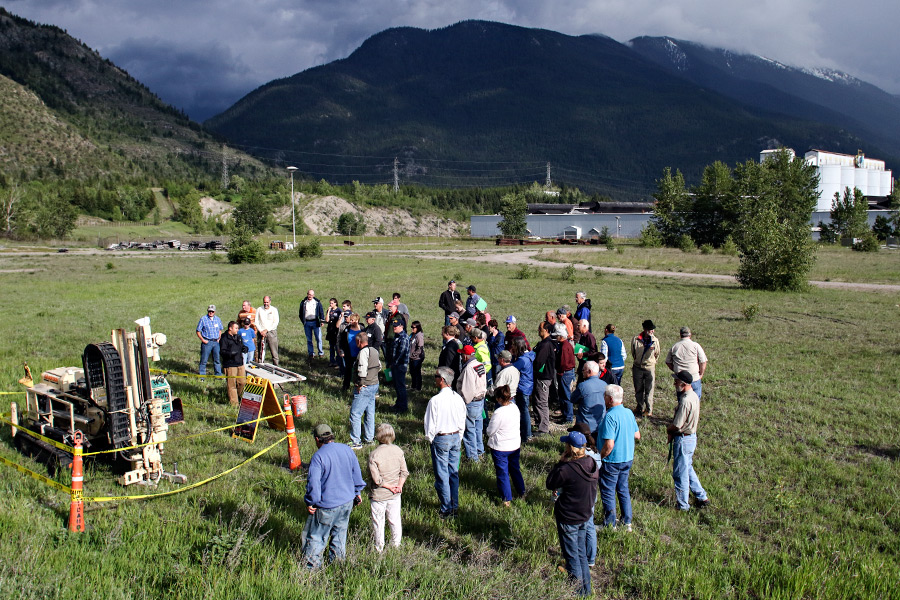Public Glimpses CFAC Cleanup Investigation, Demolition
More than 75 community members and former plant employees tour shuttered site
By Tristan Scott
COLUMBIA FALLS – Heaps of cinder blocks litter the grounds of the Columbia Falls Aluminum Co. site where the towering paste plant once stood, the remnants of a bygone era when the bustling facility was a hub of economic activity.
Known as the Black Castle by those who worked there, the 130-foot tall building struck an imperial pose for decades, looming on the outskirts of the community it helped nurture, a dark benefactor caked in the soot of a lucrative industry.
At its height, CFAC employed 1,500 workers, providing good-paying jobs and supporting generations of families in the region while producing reams of gleaming aluminum. These days, the only labor on the 3,000-acre plant site is demolition work, while a group of several environmental engineers investigates the extent of soil and water contamination.
The rubble is the most recent evidence of the ongoing demolition and recycling of most of the shuttered plant’s buildings, which dozens of former workers and residents recently toured, watching the ghost of an industry recede from the landscape.
“A lot of buildings are gone. A lot of memories in those buildings,” said Mike Shepard, a former employee who joined generations of workers on the first public tour of the site since the plant’s permanent closure more than a year ago.
The Black Castle was used to make briquettes out of coal tar, but workers recently used a massive piece of machinery to raze the structure with a shear that reaches nearly 100 feet in the air.
There’s plenty of nostalgic longing for the bygone era, but many of the approximately 75 residents who participated in the tour are more concerned about the future, including Shepard.
The firm charged with removing CFAC’s above-the-ground assets is Oregon-based Calbag Resources, which is waiting on final approval for hazardous waste removal from the Montana Department of Environmental Quality, which is overseeing permits for the demolition of buildings.
The permit will allow Calbag to remove hazardous waste and transport it to a specially permitted landfill in Oregon, in particular the spent potliners inside the aluminum reduction pots.
No demolition work can begin on the 40-acre building containing the 10 pot rooms until those materials are removed, and Shepard has accused the DEQ of dragging its feet on the permit.
“I don’t know if DEQ even knows what they’re doing out here,” said Shepard, now a member of the Columbia Falls City Council. “This is not rocket science.”
Shepard recently wrote a letter published in several newspapers saying as much, and while the council considered sending a letter to Gov. Steve Bullock asking him to apply pressure on the state agency, Calbag project manager Cliff Boyd said he’s hopeful to secure the permit soon and put a few dozen folks back to work on the project.
Meanwhile, the U.S. Environmental Protection Agency is conducting its investigation into the extent of contamination on the site, a process expected to last until 2021.
The investigation process began with initial surveying in April followed by the drilling of 43 sampling wells, which began in May and will continue through September, according to CFAC officials. Groundwater sampling is scheduled to begin in the fall, when engineers from Roux Associates, CFAC’s environmental consultant, will test for cyanide, metals, fluoride, and other possible contaminants.
After CFAC’s owner, Glencore, the largest commodities trading group in the world, closed the plant in 2009, the EPA proposed listing the contaminated site on the federal Superfund Program’s National Priorities List for environmental remediation.
The EPA’s decision to propose CFAC as a federal Superfund site prompted praise and commendation from local business leaders, the governor and Montana’s senior U.S. Senator.
Not surprisingly, company officials balked at the proposed listing, calling the Superfund program ineffective, improvident and stigmatizing, while proponents of listing said it would hold Glencore accountable.
Shannon Stringer, a former employee and a member of the CFAC Community Liaison Panel, said the community historically hasn’t had a lot of faith in Glencore.
But Glencore recently agreed to pay $4 million for the remedial investigation, and the agreement has led community members to wonder why the EPA needs to move forward with a Superfund designation, a decision that is expected to be made this fall.
EPA Remedial Project Manager Mike Cirian said the remedial investigation is the first step in a long process, but it is necessary to thoroughly investigate the site.
“We can’t start the cleanup until we know what’s there,” Cirian said. “It’s a long process, unfortunately, but we can’t clean up what we don’t know is there. We don’t have that crystal ball.”
Concerns are centered on possible ecological hazards lingering throughout the property and potentially leaching into the ground and surface waters or even the nearby Flathead River, which flows south to Flathead Lake and is a critical water source.
During those decades of humming industrial activity, tons of hazardous waste was buried on-site, as evidenced by the raised landfills that pepper the property.
The remedial investigation will help determine the condition of the landfills, and “tell us whether there’s anything leaking into your communities,” Cirian said.